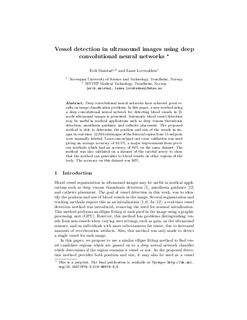| dc.contributor.author | Smistad, Erik | |
| dc.contributor.author | Løvstakken, Lasse | |
| dc.date.accessioned | 2016-11-13T15:15:42Z | |
| dc.date.accessioned | 2016-11-16T11:59:32Z | |
| dc.date.available | 2016-11-13T15:15:42Z | |
| dc.date.available | 2016-11-16T11:59:32Z | |
| dc.date.issued | 2016 | |
| dc.identifier.citation | Lecture Notes in Computer Science 2016, 10008:30-38 | nb_NO |
| dc.identifier.issn | 1611-3349 | |
| dc.identifier.uri | http://hdl.handle.net/11250/2421307 | |
| dc.description.abstract | Deep convolutional neural networks have achieved great results on image classification problems. In this paper, a new method using a deep convolutional neural network for detecting blood vessels in B-mode ultrasound images is presented. Automatic blood vessel detection may be useful in medical applications such as deep venous thrombosis detection, anesthesia guidance and catheter placement. The proposed method is able to determine the position and size of the vessels in images in real-time. 12,804 subimages of the femoral region from 15 subjects were manually labeled. Leave-one-subject-out cross validation was used giving an average accuracy of 94.5 %, a major improvement from previous methods which had an accuracy of 84 % on the same dataset. The method was also validated on a dataset of the carotid artery to show that the method can generalize to blood vessels on other regions of the body. The accuracy on this dataset was 96 %. | nb_NO |
| dc.language.iso | eng | nb_NO |
| dc.publisher | Springer Verlag | nb_NO |
| dc.title | Vessel detection in ultrasound images using deep convolutional neural networks | nb_NO |
| dc.type | Journal article | nb_NO |
| dc.type | Peer reviewed | nb_NO |
| dc.date.updated | 2016-11-13T15:15:42Z | |
| dc.source.pagenumber | 30-38 | nb_NO |
| dc.source.volume | 10008 | nb_NO |
| dc.source.journal | Lecture Notes in Computer Science | nb_NO |
| dc.identifier.doi | 10.1007/978-3-319-46976-8_4 | |
| dc.identifier.cristin | 1399872 | |
| dc.description.localcode | The final publication is available at link.springer.com | nb_NO |
